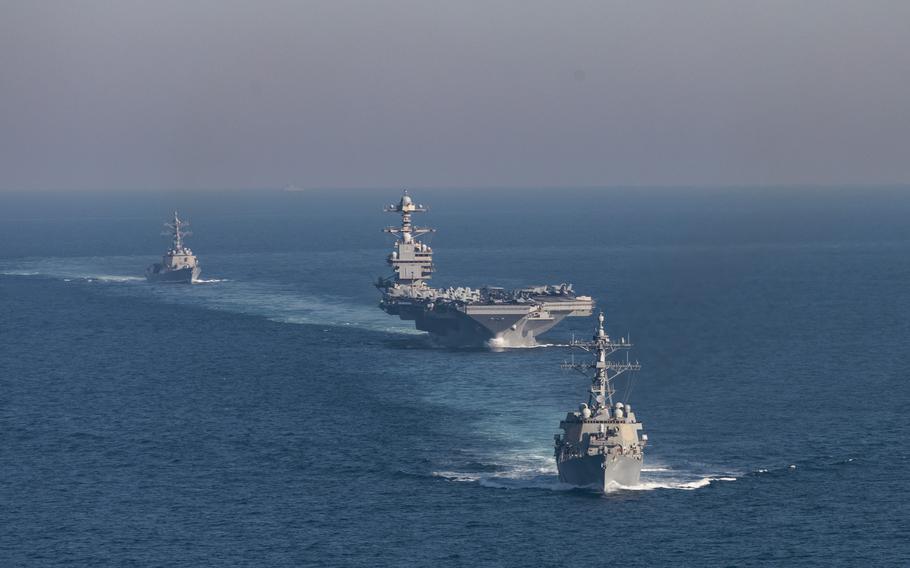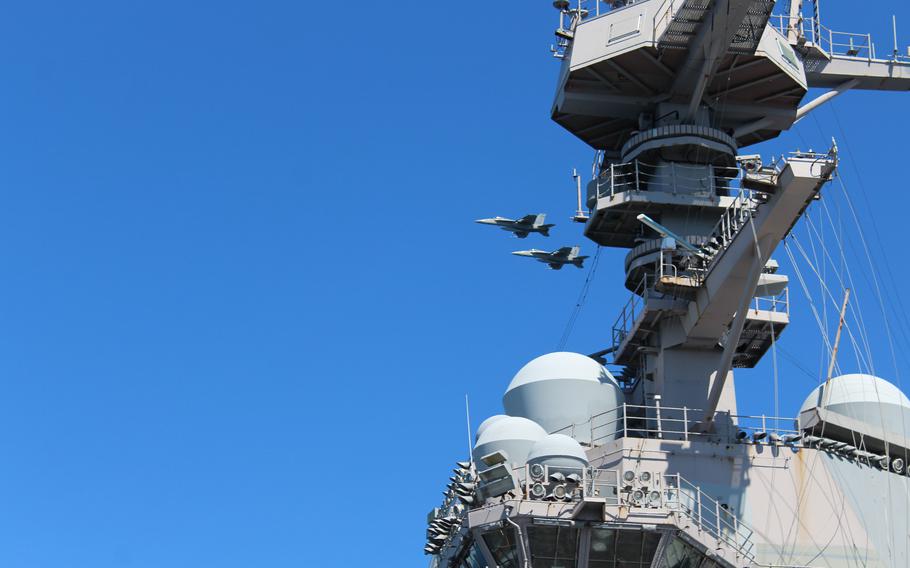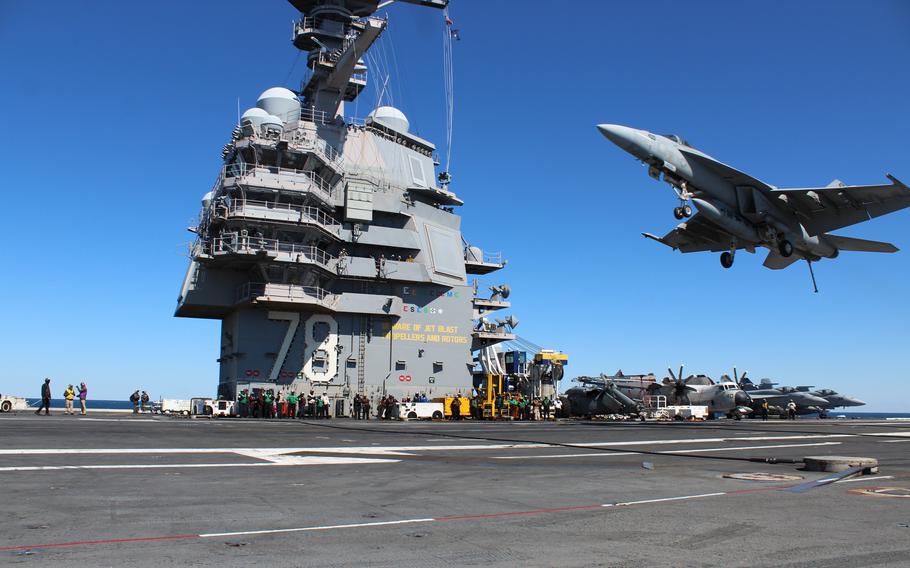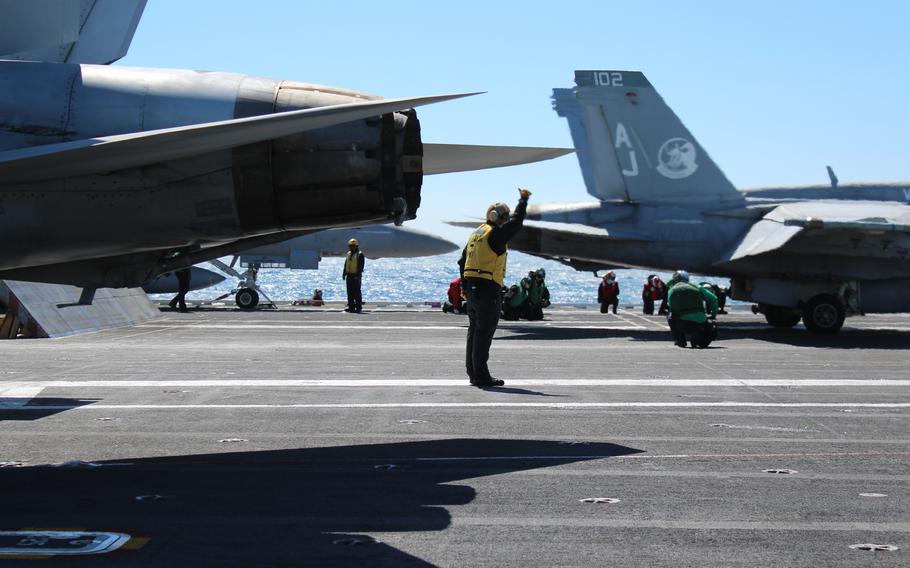
The Arleigh Burke-class, guided-missile destroyers USS Winston S. Churchill, front, and USS Bainbridge, back, escort the USS Gerald R. Ford during a training event on March 23, 2025. (Maxwell Orlosky/U.S. Navy)
ABOARD THE USS GERALD R. FORD — Two F-18 fighter jets roared above the USS Gerald R. Ford, flying past the aircraft carrier in the direction of a destroyer sitting on the horizon.
Four other destroyers were also spread across the ocean as the strike group conducted its final training exercise recently in the Atlantic, preparing for a summer deployment that could take the warships to the Middle East, where Iran-backed Houthi militants have been attacking merchant vessels regularly. If sent to the region, the strike group will put newly adapted counter-drone weapons to the test as the Navy explores alternatives to shooting down cheap Houthi drones with multimillion-dollar munitions.
The strike group’s Arleigh Burke-class, guided-missile destroyers will deploy with the Coyote and Roadrunner systems, two interceptor-style drone systems that the Navy has spent the past year developing for ship-based launches, two service officials said. The Coyote and Roadrunner systems, which were modified from existing land-based technologies, are specialized drones designed to stop other drones before they reach their intended targets. The new weapons are intended to counter Houthi drones for a fraction of the price of a standard missile typically used by the Navy.
“Those two systems are part of that attempt to get after the cost curve, give our commanding officers more options to engage the threat and ultimately be more effective in defending a high-value unit,” Capt. Mark Lawrence, commander of Destroyer Squadron 2, said aboard the Ford as the aircraft carrier trained some 100 miles off the East Coast.
Six destroyers will support the Ford during its deployment, strike group leaders said. It is unclear how many of the destroyers will be Coyote and Roadrunner capable.
The Ford was the first aircraft carrier sent to the Middle East in late 2023 to help deter the Israel-Hamas war from growing into a regional conflict. The carrier, homeported at Naval Station Norfolk, Va., spent about two months off the coast of Israel before it returned to the United States in January 2024.
The Ford and its strike group are now preparing to pick up where they left off — training for a deployment that could task the ships and the air wing with defending merchant vessels from Houthi drone attacks.
The rumble of fighter jets was constant March 21 as F-18s honed landing on and taking off from the Ford as the carrier cruised the ocean. The sway of the ship from the waves appeared to have little impact on pilots successfully tail-hooking their aircraft on the wires stretched across the flight deck.
The strike group brought aboard the nine-squadron air wing and took to the sea with its five U.S.-based destroyers for the strike group’s Composite Training Unit Exercise, the final training event that tests their ability to operate as a cohesive fighting force. When the group completes the training, which typically takes three weeks, it will be certified to deploy.
Scrimping on expensive munitions — without sacrificing the effectiveness of the mission — was highlighted during the Ford strike group’s training.
“We are looking at ways that we can be more effective against the threats that are presented — unmanned, specifically in this case — and we are trying to find ways to make sure that we are going to have the deep missile inventories we might need for other contingencies,” Lawrence said.

Two F-18 fighter jets fly over the USS Gerald R. Ford as the aircraft carrier and its strike group train March 21, 2025. (Caitlyn Burchett/Stars and Stripes)
High-end weapons, high-end threats
One-way attack drones are one of the main weapons the Houthis use to attack military and merchant ships, according to U.S. officials.
Since November 2023, the Navy has defended against nearly 400 attacks using drones and missiles in the waters of the Red Sea, a pace that has seen U.S. ships firing back at levels comparable to World War II battles.
Navy forces have fired more than 200 missiles and upward of 150 artillery rounds — missile expenditures that have cost the sea service hundreds of millions of dollars, according to Missile Defense Advocacy Alliance data.
As of January 2025, the Navy had fired 120 SM-2 missiles, priced at about $2.1 million apiece. In addition, 80 SM-6 missiles were expended, costing $3.9 million each. Twenty Evolved Sea Sparrow and SM-3 missiles were also fired, which range in price from $9.6 million to $27.9 million.
Missile expenditures are likely higher because the U.S. on March 15 began striking Houthi facilities in Yemen on an ongoing basis. The strikes will continue, the Pentagon has said, until the Iran-backed rebels pledge to halt attacks on ships transiting the Red Sea.
Navy leaders have acknowledged the expense during the past year, saying the service was working to address the modest threats with lower-cost alternatives such as 5-inch guns, while expediting the development and delivery of new, cheaper technology.
The Coyote and Roadrunner counter-drone systems are among those new technologies.
“Both are specifically designed to go after [drones] so we don’t have to shoot the big standard missile at them. From inception to fielding and testing — all have been done in the last year. That’s a pretty quick turn for the Navy,” said Adm. Daryl Caudle of U.S. Fleet Forces, the command that oversees the training and equipment of East Coast-based naval forces.
The Coyote is a small, expendable, tube-launched drone that can be deployed from the ground, air and ships. Defense technology company Northrop Grumman, a Coyote developer, describes the drone as agile, with the ability to perform high-speed maneuvers and climb to altitudes above 50,000 feet before “pouncing” on its target at supersonic Mach 3.5 speeds.
The system has been developed for 25 years, but the variation that will be used by destroyers supporting the Ford’s 2025 deployment was recently adapted and tested at sea in August. Neither the company nor the Navy has said how much the Coyote costs per unit, but a similar model developed by Raytheon for the Army costs about $125,000 per unit.
The Roadrunner, dubbed a “drone hunter,” is a twin jet-powered autonomous air vehicle that was unveiled in late 2023 by tech company Anduril. The Roadrunner can detect, track and engage targets at significant distances, according to the company. The system can be operated manually or autonomously.
When the system was announced, Anduril declined to identify its customer, but the Defense Department has awarded the company contracts to develop drones for the Navy since at least June 2024. Company executives have said the cost of the system was in the low hundreds of thousands of dollars, but the price tag was expected to decrease when mass production began.
It took the Navy only seven months — from January to August 2024 — to develop the original land-based concepts of both systems for ship-based use and begin at-sea testing, said a Navy official who spoke on the condition of anonymity. The at-sea testing of the systems was supported by $88 million in congressional supplemental funding.
The official said the sea service, as well as other services, “pursued a plan” to test and field the systems rapidly in response to the Houthi attacks on military and merchant vessels in the Red Sea. U.S. drone pursuits in the past year have coincided with defense officials raising the alarm on the Navy’s increasing missile expenditure, which they say is eating up U.S. inventory that would be needed in a potential conflict with an adversary such as China.
Former national security adviser Jake Sullivan said in December that there was a need to stockpile munitions and invest more in low-cost weapons such as drones after sending billions of dollars in military aid to Ukraine and the Red Sea threat collectively depleting U.S. shelves.
Less than a month earlier, Adm. Samuel Paparo, the commander of U.S. Indo-Pacific Command, said he was dissatisfied with U.S. munitions stockpiles at a time when China is conducting a historic amount of large military exercises.
“The ultimate goal for development of these systems is to counter threats posed by drones more efficiently, which will preserve high-end weapons for high-end threats,” the Navy official said.

An F-18 fighter jet pulls up to fly over the USS Gerald R. Ford while the aircraft carrier and its strike group train March 21, 2025, approximately 100 miles off the East Coast. The strike group is at sea training to test the group’s ability to operate as a cohesive fighting force. (Caitlyn Burchett/Stars and Stripes)
‘Systems with promise’
While the military services have been working in earnest to develop drones for more than 10 years, the deployment of the Coyote and Roadrunner systems indicates a push to get the technology in the hands of troops, according to one defense analyst.
“Most counter-drone systems, including the Coyote and the Roadrunner systems, have not become programs of record for the Defense Department or the services,” said Mark Cancian with the Center for Strategic and International Studies, a Washington think tank. A program of record is one that has been formally funded by the government for mass production after extensive development and testing, often a process that takes years.
But pushing these systems to the fleet now, Cancian said, is a “very sensible thing” for the Navy to do.
“It is a great way to test the system before mass production. And given the immediacy of the threat in the Red Sea, it could be a risk the Navy has decided is worth taking,” he said.
It was recommended by the Defense Innovation Board in January that the Pentagon “act with the urgency that the changes in warfare and chaotic world security environment demand” to develop and field drone technology.
“We cannot afford the time to find perfect answers for each question,” the board said. “We must get unmanned systems in the hands of the warfighters in sufficient quantities to matter now.”
Cancian said the Navy is likely leaning on lessons learned from Ukraine’s use of drones in its war with Russia. The U.S. sent drones in the developmental stage to Ukraine to help beat back Russia’s invasion.
“We used Ukraine as an operational test,” he said.
But there is not much available to the public on what the U.S. learned about what works and what doesn’t. Standard missiles, Cancian said, should still be relied on for faster, more sophisticated weapons. At least until the testing is completed.
“These are systems with promise, but they have limited target capabilities. They are good against slow, low-flying targets but not much else,” Cancian said.

An F-18 fighter jet prepares to launch off the USS Gerald R. Ford as other jets maneuver the flight deck March 21, 2025, while the aircraft carrier’s strike group conducts training. (Caitlyn Burchett/Stars and Stripes)
‘Tried-and-true’ weapons
While the Ford strike group learns the new counter-drone systems, they will lean on conventional weapons, such as the standard missiles and 5-inch guns, strike group leaders said.
“In the meantime, we are also making sure our ships and our crews have confidence in the tried-and-true SM-2 capability, because that’s a no-fail mission. So, while we work on fleet initiatives to really get more efficient, I’d say we remain laser focused on staying effective,” Lawrence said.
However, he declined to comment on the integration of the technologies across the strike group, stating he would “leave the specifics aside.”
Rear Adm. Paul Lanzilotta, commander of the Ford strike group, echoed Lawrence’s confidence in the weapons that have been a mainstay of the Navy’s deterrence efforts for decades.
“When you see a guided-missile destroyer on the high seas and her 5-inch gun points, God forbid, in your direction, you ought to be thinking twice about what’s coming next because it’s a very effective weapon,” he said.
The Ford is scheduled to deploy in the summer to the 6th Fleet area of operations, which includes waters surrounding Europe and Africa. The strike group will consist of the Ford carrier and six destroyers — five based in the U.S. and one based out of Rota, Spain. Aboard the ships will be an air wing made up of nine aviation squadrons, including four F-18 fighter jet squadrons and one electronic attack Growler squadron.
The U.S.-based destroyers are the USS Winston Churchill from Naval Station Mayport, Fla., and the USS Mitscher, USS Mahan, USS Bainbridge and USS Forrest Sherman, all from Naval Station Norfolk, Va. An unidentified destroyer out of Spain will support the strike group as needed.
The strike group, Lanzilotta said, could be asked to deploy sooner. And it could be directed instead to sail to the Middle East in the 5th Fleet area of operations.
The aircraft carrier USS Harry S. Truman has been conducting operations in the Red Sea against the Houthis. The Truman was due to transit home to Norfolk at the end of March, but its deployment was extended by at least one month.
The aircraft carrier USS Carl Vinson, which has been operating in the Pacific, was ordered to steam toward the Middle East. The Vinson, which was slated to transit home to San Diego in mid-April, will extend its deployment by three months. The aircraft carrier USS Nimitz was deployed last week for likely the final time to the Pacific.
“With the rest of the things going on in the world, we bring the secretary of defense and the president of the United States options for potentially going sooner. And our sailors have that mindset every single day,” Lanzilotta said.